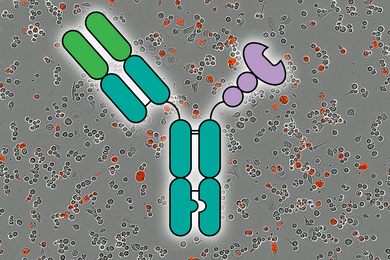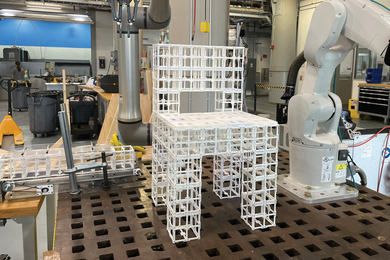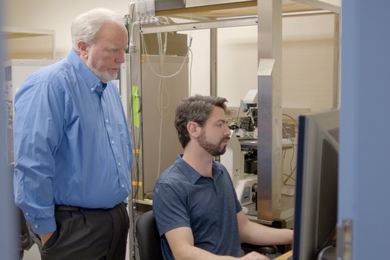A group of scientists and engineers, including MIT Assistant Professor David Mindell, made news this summer when their deep-sea archaeological expedition in the Mediterranean Sea discovered eight ancient shipwrecks, with artifacts that include amphorae used for carrying wine and oil along the trade route between Rome and Carthage.
Dr. Mindell, the Frances and David Dibner Assistant Professor of the History of Engineering and Manufacturing in the Program on Science, Technology, and Society (STS), was co-principal investigator on the expedition. He also designed portions of Jason, the robot used to recover the artifacts and map the shipwreck sites. The oldest of the ships dates to about 100 BC.
Professor Mindell has a special interest in the amalgamated discipline of deep-sea archaeology, which is created by the fusion of traditional marine archaeology with engineering and oceanography. He is teaching a new course dealing with a similar topic this fall, a joint STS/electrical engineering subject dealing with the structure of engineering revolutions.
"I wear two hats in this work," said Professor Mindell. "As an electrical engineer, I work with other scientists to develop precision navigation control and mapping technologies for the deep ocean. And as a historian of science and technology, my interest is in how archaeology, engineering and oceanography come together to develop scientific procedures for this deep-water archaeology."
Deep-sea archaeology differs from its traditional land and marine cousins in several ways, most notably in accessibility. While marine archaeological expeditions in shallow water along the coast are not uncommon, they are essentially an extension of land archaeology in that they are accessible enough for divers to continually investigate the same site over a long period of time, said Professor Mindell. That type of marine archaeology is limited to depths of a few hundred feet, the maximum depth that divers can safely traverse.
Deep-sea archaeology, on the other hand, studies the remains of ships that sank in water far from shore, and it requires the ability to view and retrieve objects at depths greater than human divers can manage. Submarines are useful as search tools, but it was the appearance of robots like Jason -- with special systems designed specifically for underwater navigation, mapping and object retrieval -- that really made the field of deep-sea archaeology possible.
"Right now, we're the only group in the world that can do this," said Professor Mindell. "We have the most accurate deep-water navigation system that exists."
NAVY ASSISTANCE
Aided by the US Navy's NR-1, a nuclear-powered submarine once used only for military missions, the researchers located the sunken ships using long-range sonar while traveling near the ocean floor. Professor Mindell was chief scientist and search director on one three-day dive of the NR-1 that discovered the most significant of the ancient wrecks.
"The submarine's sonar can 'see' about 1,000 yards. We saw a blip that wasn't on our search route. Most blips turn out to be nothing, but we decided to check this one out," he said of the discovery. "When we got close enough, we could see scores of ancient artifacts lying exposed on the ocean floor. We were elated."
The group then returned to the site with Jason, the Volkswagen-sized robot developed by a team of researchers at the Woods Hole Oceanographic Institute (WHOI). The robot was transported by ship and lowered into the ocean at the end of a long fiber-optic tether.
Jason's pilot, navigator and chief scientist remained in a control room on the ship, where they guided the robot as it performed its various duties, including the creation of a digital photomosaic of the underwater site in about four hours. Brendan Foley, an archaeologist and STS graduate student, used a computer to help create the mosaic from nearly a hundred different images.
With this photomosaic in hand, the researchers in the control room used the robot's mechanical arms and hands to retrieve delicate artifacts, which were lifted to the ship in an elevator-like device. Every artifact was carefully photographed and its location and orientation recorded before it was removed from the site.
"We reconfigure Jason between dives while we're on site, putting on the type of tool needed to grab certain kinds of artifacts. For larger pieces, we put on big snowshoe-like nets that allowed it to lift and carry the amphoras without damaging them."
FATEFUL STORMS
Researchers assume that the wooden sailing ships, found strewn over a 20-square-mile area about half a mile beneath the ocean's surface, were sunk by storms and not by crashing into rocks or reefs that would have damaged the hulls. Thus the cargo would have remained in much the same configuration as it had been stored, except for what the crew may have thrown overboard in a futile attempt to avoid sinking.
"These wrecks are absolutely pristine. Of course there is biological decay of the ship itself, but things are arranged exactly as they were the day it sank, with the same physical relationship between objects in the cargo holds," Professor Mindell said.
The wrecks included five ships from ancient Roman times; one Islamic ship, probably medieval; and two sailing ships from the 18th or 19th century. The oldest wreck, about 120 feet long, had two cargo holds containing bronze vessels, at least eight types of amphorae for carrying foodstuffs, an array of kitchen and other household wares and two large lead anchors. The largest amphora was about five feet tall. In order to confirm the estimated dates of the wrecks, the researchers retrieved 115 artifacts, all of which will undergo a careful and lengthy process of conservation.
"Precise measurement is what made this a scientific expedition," Professor Mindell said. "If somebody comes to our wreck in 100 years seeking answers to new questions, they will be able to determine the answer by looking at our data. At a land site, researchers can spend 30 years cataloguing and studying. Even at a traditional marine site, researchers can return to dive in the same place every summer. But because of the cost and logistics, the time spent at a deep water site will be closer to 30 days."
The group used a navigation system designed by Professor Mindell, along with a suite of other sonar sensors to create precise photomosaics and microtopographic maps with centimeter-scale precision. Jason, which is able to hover autonomously in the water above a site by continually reassessing its position, automatically traveled over and around the shipwreck site, taking digital photographs and sonar readings to create the images.
The resulting images are exceptionally clear digital photographs of the amphorae and other cargo lying on the ocean floor, devoid now of any protective wooden structure between them and the mud and water.
"Acoustic mapping is just like photography, but with sound waves," said Professor Mindell. "With photographs, you shine light at an object and record the reflections; with acoustic mapping, you bounce sound off it and record the reflections. In the ocean, each of these types of scattering tell you different types of things; hence a map that fuses them is best."
Professor Mindell's navigation system, called EXACT, works at an acoustic frequency of 300 kHz and navigates three to five times per second to an accuracy of about a cubic centimeter within a 100-cubic-meter volume. By comparison, a traditional, commercially available system works at an acoustic frequency of 7-14 kHz and would navigate Jason about once every 10 seconds with an accuracy of a few meters, but over a much larger volume (several cubic kilometers).
Professor Mindell's work on Jason's control, navigation and mapping systems was supported by a grant from the Office of Naval Research. Jason's mapping system has been a collaborative research project, with Dana Yoerger and Hanumat Singh of WHOI and Louis Whitcomb of Johns Hopkins University. The Mediterranean expedition was sponsored by the National Geographic Foundation through the Institute for Exploration in Mystic, CT, headed by Robert Ballard, who was chief scientist on the expedition.
The group's future plans call for the exploration of the Black Sea, an important link between the Mediterranean and Asia in ancient times. Because the Black Sea lacks oxygen at depths greater than 600 feet, biological decay of ships on the ocean floor is unlikely, adding a special appeal for deep-sea archaeologists.
"There's the potential that if you find an ancient wreck in the Black Sea, it will be perfectly preserved," said Professor Mindell. "The extreme of this vision is that the sails will still be up and the people will be sitting at the oars."
A version of this article appeared in MIT Tech Talk on September 10, 1997.





